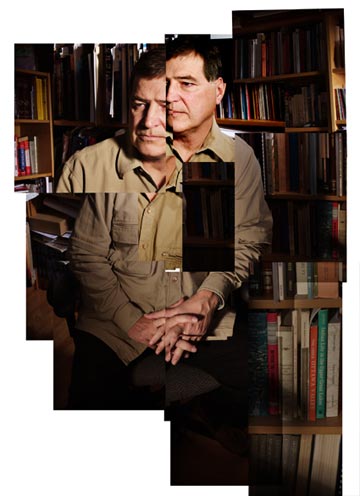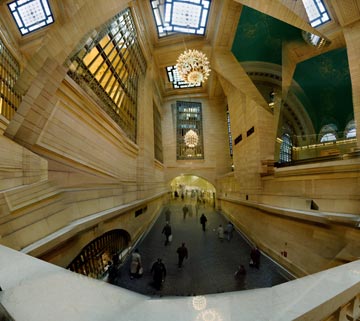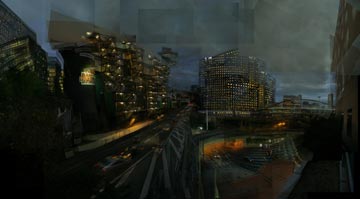A former commercial photographer, Yves Médam has only recently made the shift to fine art in the last 3 years. The French-born artist constructs large format photographic re-inventions of reality, creating a collage of multiple images. It is almost a cubist reinvention in its form. Médam, represented by Galerie Dominique Bouffard, was recently featured in a showcase of Montreal artists at the World’s Fair in Shanghai. I have translated the interview below from French.
Stefan Zebrowski-Rubin: Tell me about your work, its evolution and inspiration.
Yves Médam: For the first 15 years of my career, I worked as a commercial photographer. I had an artistic approach but always within the commercial realm. Then, photography changed enormously; it went digital and image banks became popular. It became increasingly difficult to work. Photography became a banal practice. Today, everyone thinks he’s a photographer, everyone has an opinion about how to tweak an image. Thus, I wanted to leave photography. But simultaneously, I also loved my work. I told myself if I continue taking photos, I need to find a way to make it more personal and meaningful, find an approach all my own.
At that moment, I had a contract with the magazine Parcours. With each issue, the editor-in-chief commissioned an artist to create all the portraits in whatever style they wanted. It was a great opportunity; it was both a job as well as a chance to try something new. Would I play with lighting? A lot has been done with lighting. Would I play with form? Maybe it would be form. And I started to play.
I had seen David Hockney’s Composite Polaroids (or “joiners”) project that I really enjoyed. He deconstructed his subject on the photo plane and created a composite, a collage of photos. It created an interesting result; it was recognizable yet original. Of course, I couldn’t simply recreate it. Thus, with this magazine assignment, I started to overlap my photos, glue them together. People were wowed but for me, I was inspired by the sense that there was something more in this method, in this first beginning.
I then traveled around and started taking many, many photos of places and spaces. When I returned, I had a wealth of material. Just putting all of the photos together wouldn’t be very interesting because, really, it would just be a huge photo with a slight distortion. So I started overlapping photos, just letting myself go and explore. And voilà, I found my working style. I realized that every time I worked on a different space, with different photos, it was always the same thing but slightly different. It is the same gesture, like that of a painter putting paint on his brush, the same brush, the same paint, the same canvas. But each time, he needs to rethink the way he wants to work. It’s always different. I’m not interested in having a set formula. Every time I work, I am surprised by the end result.
All the arts, whether painting, sculpture, drawing, even music, take time. There’s always a back-and-forth, an evolution. It’s that sort of work I was interested in, that space that is almost sacred, almost of God. I think that in the act of creation, something that you don’t understand, something that happens. Sometimes it is just a gesture that brings you somewhere, but it wasn’t you that decided, it was something else. The canvas? The photo? You? Or something between the two? It’s this space between you and your creation that I find extraordinary, that I find magical.
This way of working that I have developed takes a week, a month, sometimes I rework something, revisit it like a painter would, I insert colour, change shapes. There is something at once realist, yet also abstract. I don’t care if the result isn’t accurate. Working like this with photography, I thought, what I am doing is the opposite of photography. It isn’t an instant process, and I am not photographing the real. I do photograph reality, capture real things, but after I construct the imaginary, working with shapes and time. I photograph a time-place over the course of an hour and then I mix everything that has happened during that hour, inventing something that is real but that never took place. People cross paths but they were never in the same place at the same time. I invent moments, it’s a distortion of space and time.
SZ-R: What is the resulting image, if not photography? What material do you use? Is your entire process digital?
YM: I create large format prints. And it couldn’t be anything but a digital process. What I do with photos in Photoshop, I wouldn’t be able to create transparencies, change opacities, see one photo behind another. I have more choice, more possibilities, it gives me something more interesting because, like painting, there is depth. This digital work creates depth.
SZ-R: Technology and tradition are, without a doubt, mixed in your oeuvre. It is at once cubist in its final form, but, of course, couldn’t exist without technology.
YM: Effectively, there is something cubist within my work, it’s certain, the blocks make you think of the cubist form. At the same time, the cubists were fascinated by the city and created work inspired by it, its urban movement, which greatly interests me. How to translate urban movement? How to translate the city? How to translate life? You can’t translate it in a fixed image, life moves all the time. But how to achieve the impression of movement with a static image? You can achieve that through blur, but that’s already been done. I wanted to find another way. In a way, I’ve updated the cubist style using new technologies. It’s engaging to rethink art history through a new lens. But I’m not sure what I’m doing, you know? I don’t think consciously about it. These references appear unconsciously. Things happen by accident, unintentionally, by magic.
SZ-R: What are you currently working on?
YM: At the moment I am working on a series about beaches for an exhibit starting in October at Galerie Dominique Bouffard called Kaléidoscope. I wanted to do work about beaches because the recurring themes of my work revolve around time, stillness and impermanence. The beach is a place that is never permanent. The sand is never the same, the ocean moves constantly. In the sky, everything changes, the light, the clouds… It is continuous movement. The people who come to the beach are in transit. No one lives at the beach. It’s the opposite of the city, there are no boundaries, no barriers. How to translate this movement into a photo? That’s the challenge. I am thus reworking the photos that I took in Morocco and Lisbon.
SZ-R: As an art historian and art journalist, I live and experience my interpretations of art, the ideas of art. When I’ve sat down in conversation with artists, it isn’t necessarily intellectual ideas (of deconstruction or what have you) that drive them.
YM: When I started to make these constructions, I saw that I was trying to say something about time. At a given moment, instead of taking a photo in 1/60th of a second, I was making a photo over an hour. Yet, also, to translate everything that happened in an hour into a photo, you have to lie.
Yet, when you start to work on the construction of buildings, there is automatically a visual distortion. It’s this distortion that becomes interesting because it is correct –light, gentle and inventive. I am recreating something that actually existed. It is the building, but at the same time it is perceived, surreal. It is a city but it is imaginary at the same time.
I like the idea of playing with the true and the false. That’s what I think photography is, in fact. Picasso said: “Art is a lie that makes us realize truth.” It is both true and false. This is what artists try to uncover and discover, that line between the two. It’s not defined, and it’s that quality which is so interesting. It’s that which we don’t see, something that is there but that is invisible. I think artists try to discover what we cannot see. And everyone sees something different.










